Ciabatta Bread
This easy ciabatta bread recipe results in beautiful rustic loaves of classic Italian bread, with its perfectly chewy interior texture studded with those wonderfully large air bubbles. It’s practically begging to be dipped into your favorite soup or stew.

I have such a love affair with baking homemade bread; the smell of yeast and fresh, rising dough has such a calming effect.
It makes me want to curl up on a covered wrap-around porch and read during a rainstorm.
Why You’re Going to Love It
I've long loved ciabatta bread for its chewy exterior and soft crumb speckled with air holes. It's the perfect bread for dunking into soup, slicing horizontally and making a sandwich, converting to garlic bread, or for simply slathering with butter and eating until your heart's content.
This recipe is not complicated, although it does take a little bit of planning ahead. Actual hands-on time is less than an hour in total, and the dough is very forgiving. Let’s dive into the details of the recipe!
Ingredients Overview
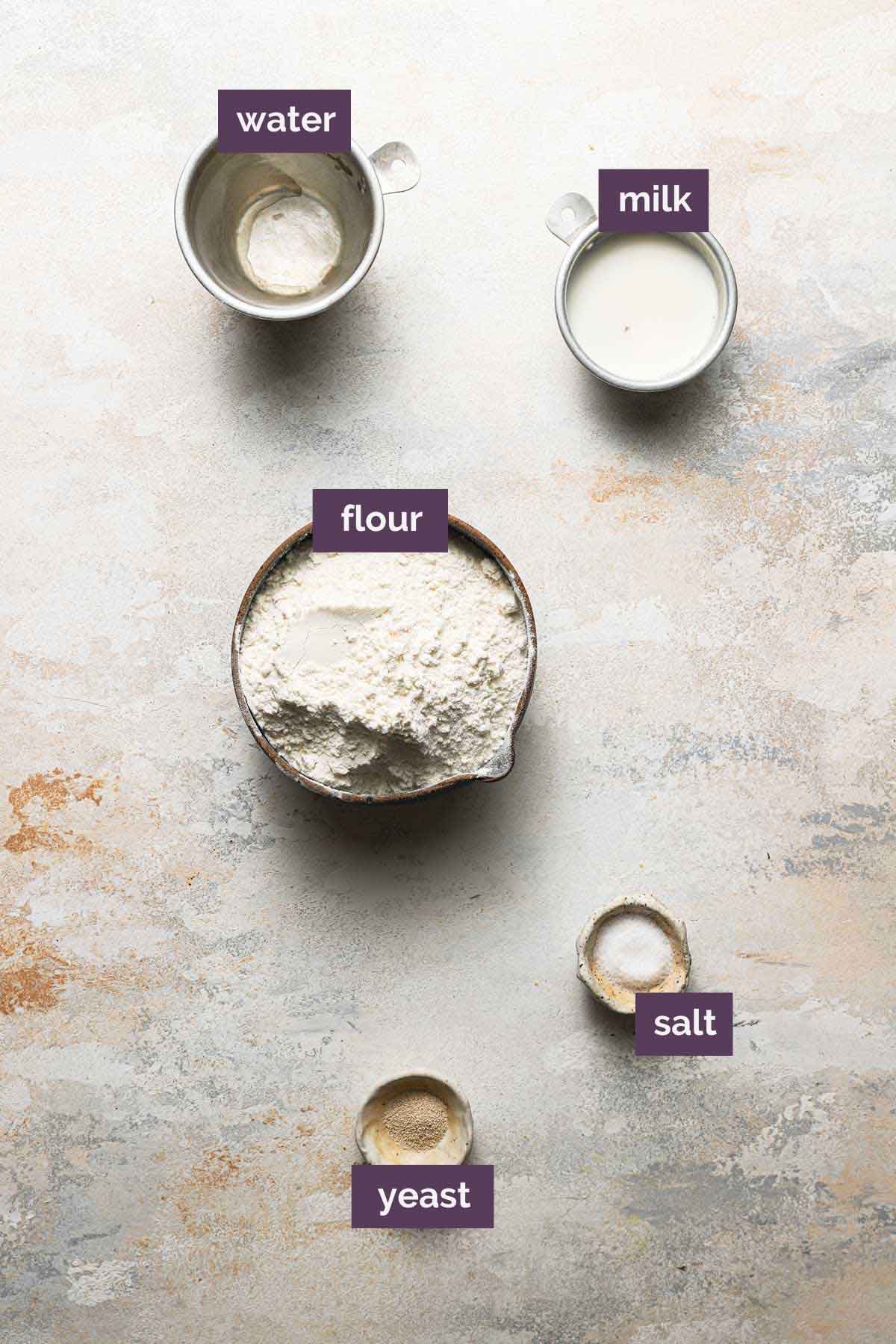
The beauty of this bread is its incredibly simplistic and rustic nature. Below is a quick overview of the ingredients we use with some notes on them and substitutions you may be wondering about:
- Flour – For this recipe, we use all-purpose flour. It has the perfect amount of protein to produce a ciabatta with a perfect rise and airy texture. Substituting bread flour will result in a denser, chewier, and less airy loaf of bread.
- Yeast – We use instant yeast, which is easily mixed into dry ingredients. If you need to substitute active dry yeast, be aware that you will need to activate it in both the sponge and the dough by first ensuring that the water is warm (100 to 110 degrees F), sprinkling the yeast over the water, giving it a quick stir, and then waiting 10 or 15 minutes, until it becomes foamy. At that point, proceed with the rest of the recipe.
- Water – A vital component! Ciabatta dough is considered a high-hydration dough because of the ratio of water to flour. For this reason, you will notice that it is rather sticky and a very wet dough. We’ll talk below about how best to handle the dough.
- Salt – Not only does this help to balance flavors in bread, but it also aids in coloring the crust, controlling the rise, and developing gluten. Don’t leave it out!
- Milk – A protein in milk helps to control the size of the air bubbles in the bread. Without it, the holes are larger, which doesn’t leave as much bread structure. The best milk is whole or 2%, but 1% can also be used in a pinch. You can also substitute 2 tablespoons of nonfat milk powder (increase the water in the dough step to 1 cup).
Ciabatta Dough: Two Parts
The dough for ciabatta bread is made in two stages:
- Sponge (or Biga) – This first mixture is prepared the day before you plan to bake the bread. It is comprised of just flour, yeast, and water. This fermented sponge is what gives the ciabatta its amazing, slightly tangy flavor.
- Dough – The next day, you will mix together the dough, which will include the sponge that has been sitting overnight.
How to Make the Dough
Let’s walk through how the dough comes together:
Step #1: Make the Sponge – You’ll mix together the flour, yeast, and water with a wooden spoon, cover the bowl with plastic wrap, and let sit overnight or for up to 24 hours.
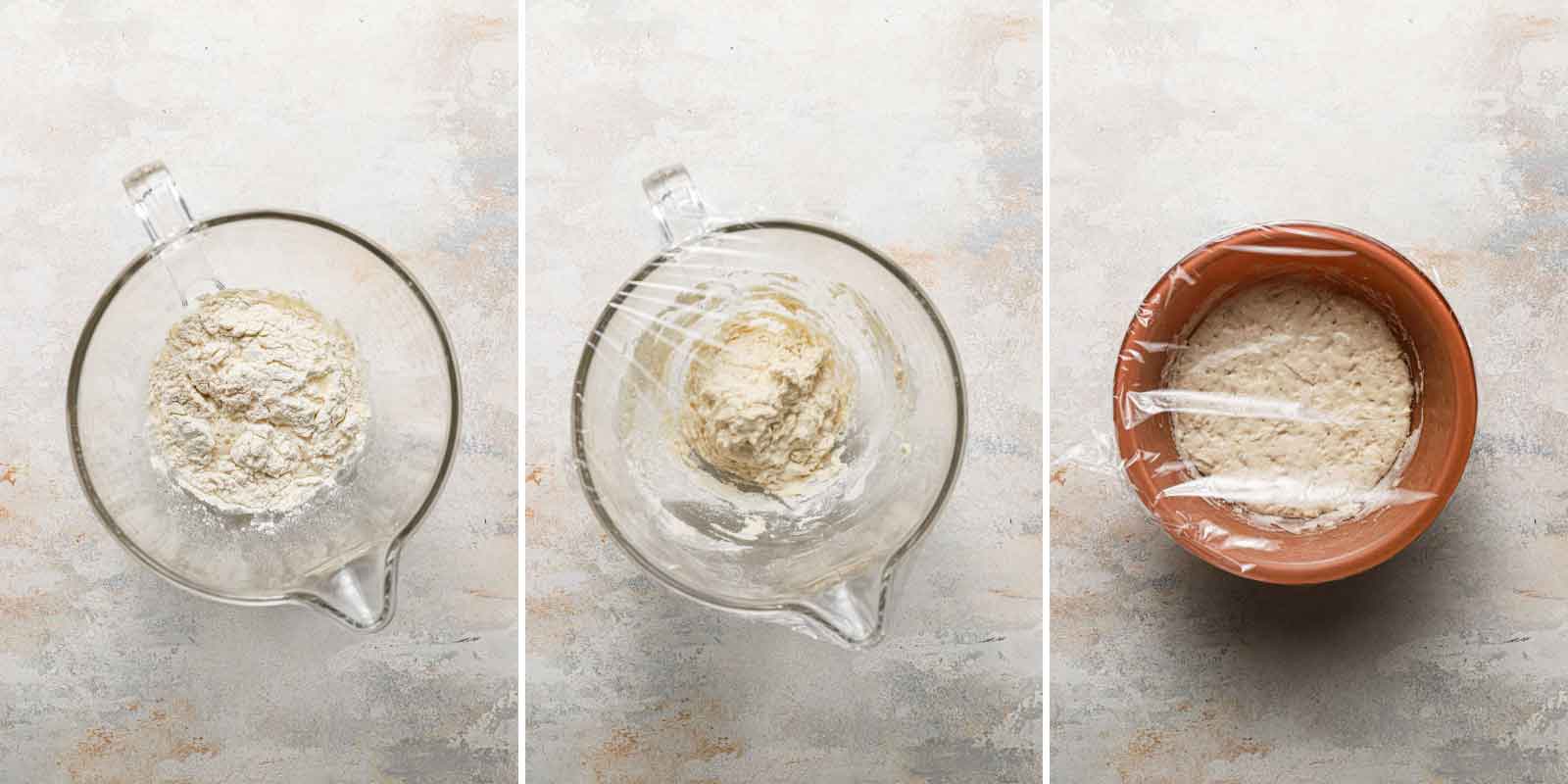
Step #2: Mix the Dough – Add the sponge and all of the dough ingredients to a stand mixer and mix with the paddle attachment until it becomes a uniform mass and pulls away from the sides of the bowl. Switch to the dough hook and knead until the dough is shiny and smooth (about 10 minutes).
Step #3: Rise – Transfer the dough to a bowl, cover with plastic wrap, and set at room temperature until doubled in size (about 1 hour).


Folding the Dough
This folding process may seem tedious, but it is an integral part of achieving those picture-perfect air bubbles! Here is how you do it:
Make sure your spatula or bowl scraper is sprayed with cooking spray (or rub it with olive oil).
Then lift the end of the dough over itself toward the middle, rotate the bowl 90 degrees, repeat, and then six more times, for a total of 8 times.
Save This Recipe
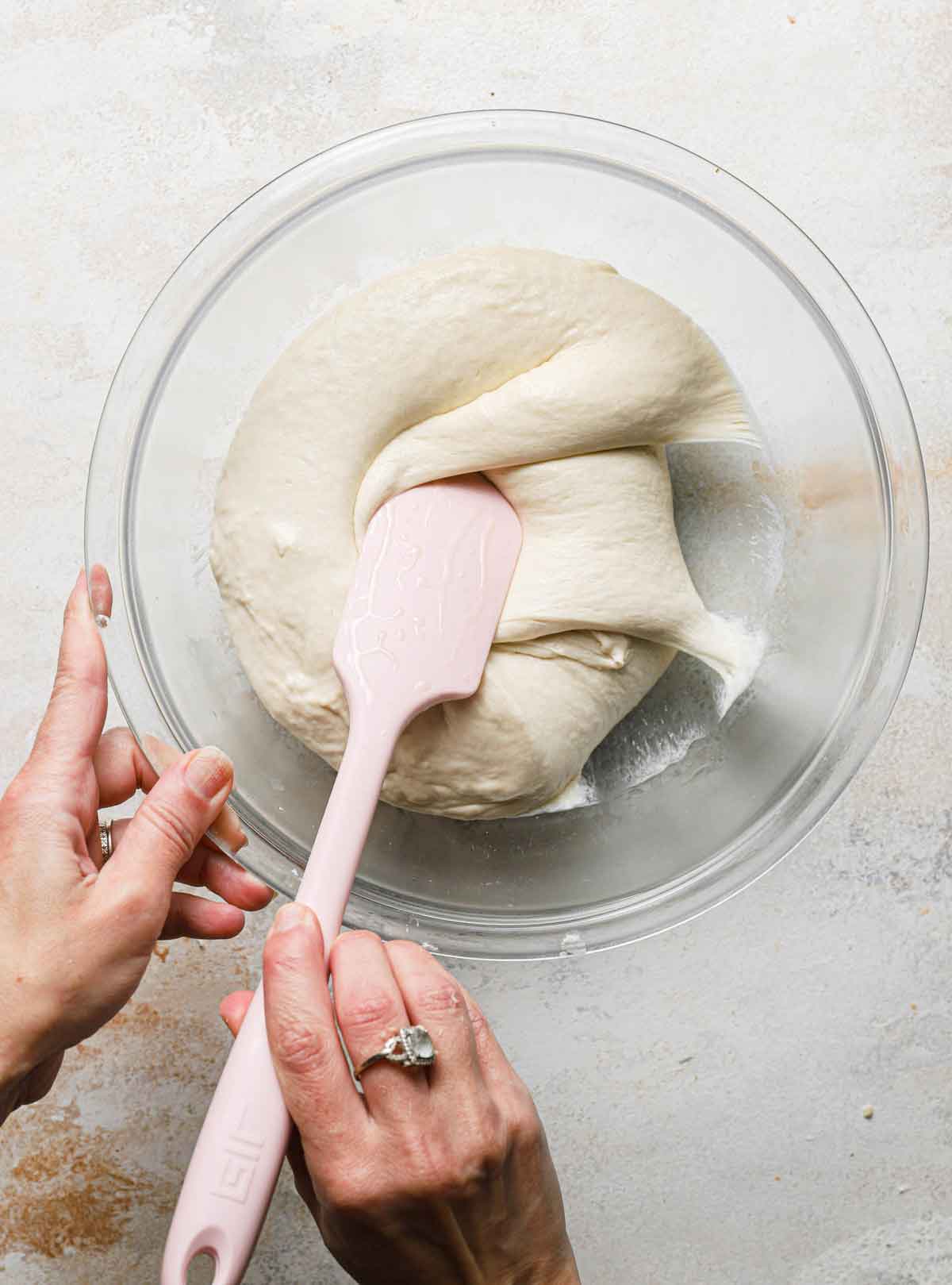
Cover the bowl with plastic wrap, let rest/rise for 30 minutes, then repeat the exact same folding process again.
Once done, cover the dough once more and allow to double in size before proceeding with shaping.
Shaping the Ciabatta
The final shaping of the ciabatta before baking is what gives the bread its characteristic “slipper” shape, from which its name originates (“ciabatta” means slipper in Italian; the bread was given this name because its shape resembles a well-worn slipper).
Shaping Step #1: Turn the dough out onto a floured surface gently (so it does not completely deflate), dust it with flour, and divide in half with a bench scraper.
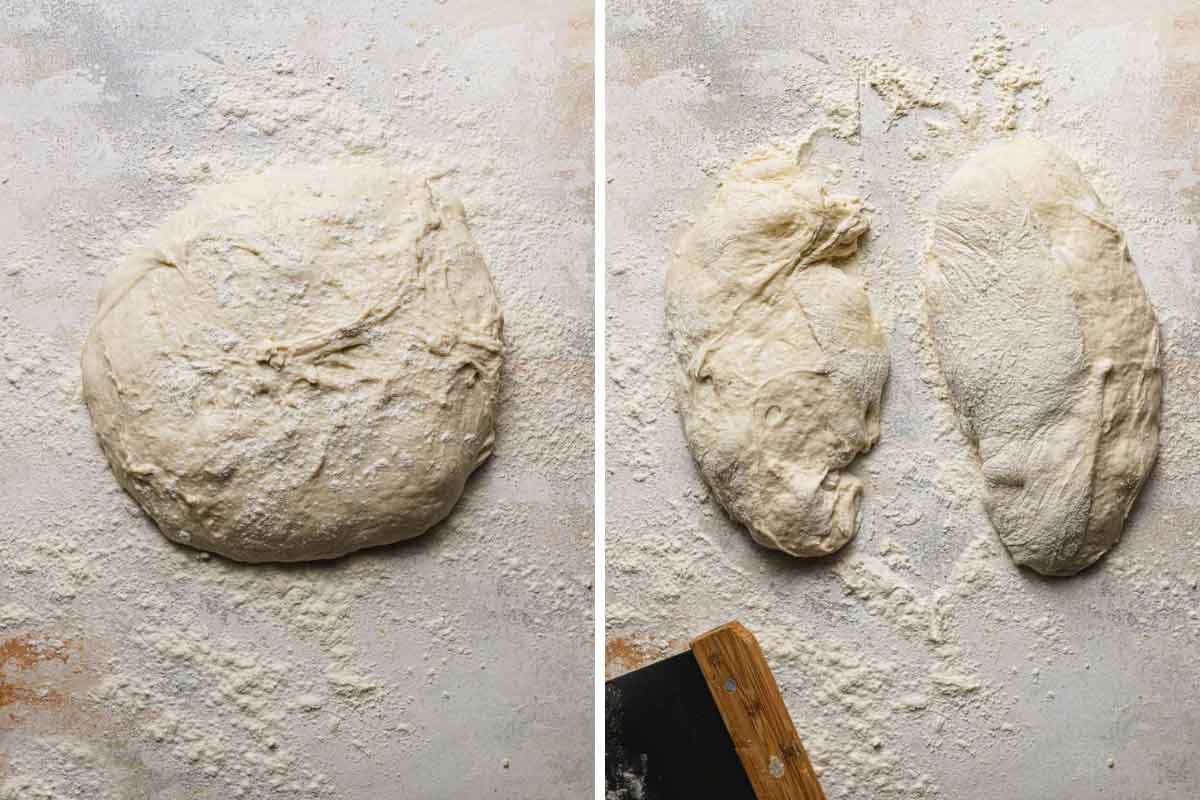
Shaping Step #2: Place one piece of dough cut-side-up and dust with flour, then using fingertips, gently press the dough into a 12×6-inch rectangle. Fold one end of the dough towards the middle, and fold the other end over the top of the first fold (as you would fold a letter in thirds). Repeat with the second loaf of dough.
Shaping Step #3: Transfer each loaf to a rectangular piece of parchment that has been dusted with flour. Dust the tops of the loaves with flour, cover with plastic wrap, and allow to sit for 30 minutes.
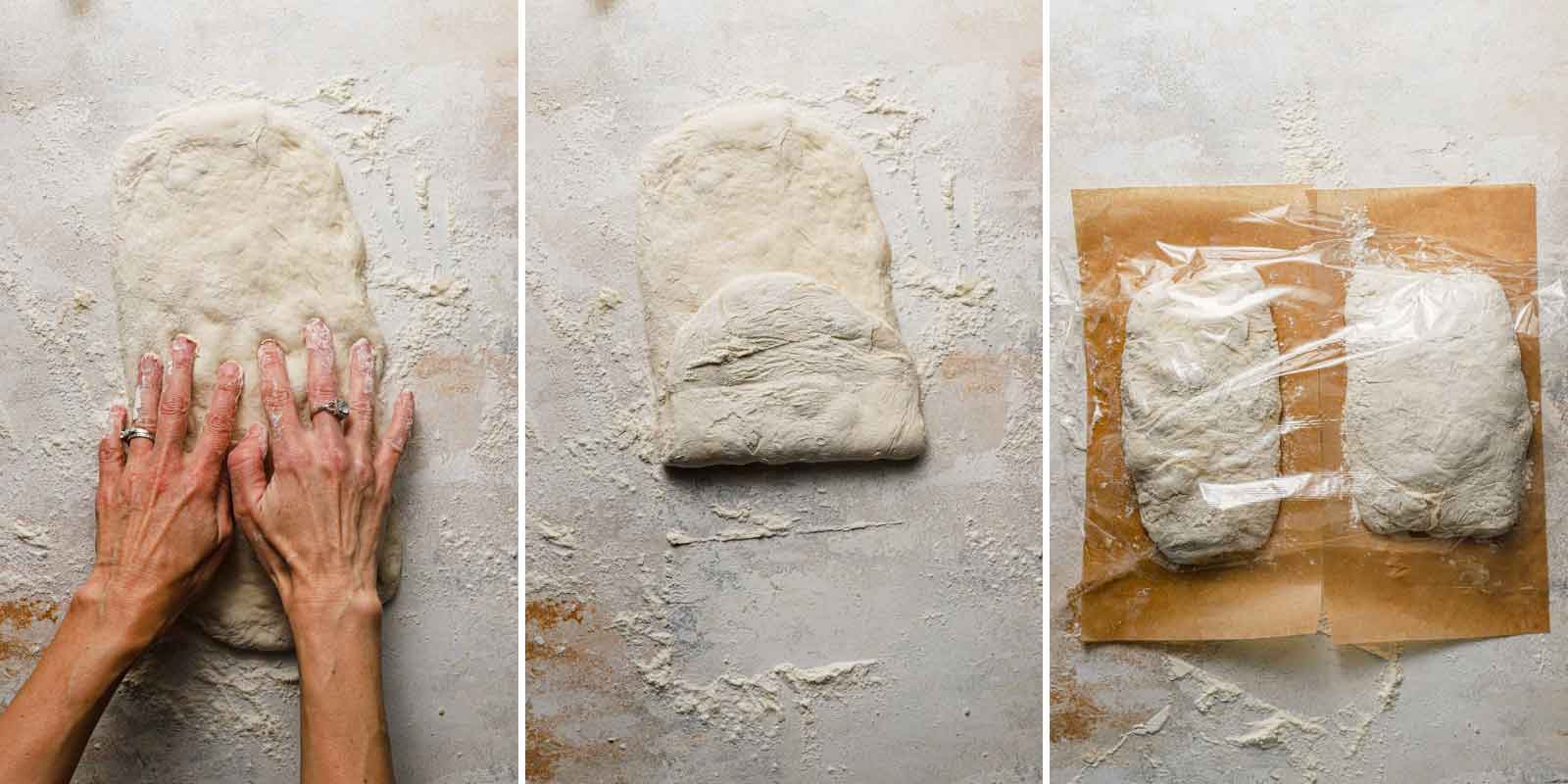
Baking the Bread
When the 30 minutes is up, you will slide the parchment pieces with the loaves onto a pizza peel. Use floured fingertips to poke the surface all over to create a 10×6-inch rectangle. Lightly spritz the loaves with water and slide the loaves onto a preheated pizza stone in the oven (you can also use an inverted baking pan, see notes below).
Spray with water twice more during the first 5 minutes of baking, then continue baking until the internal temperature registers 210 degrees F.
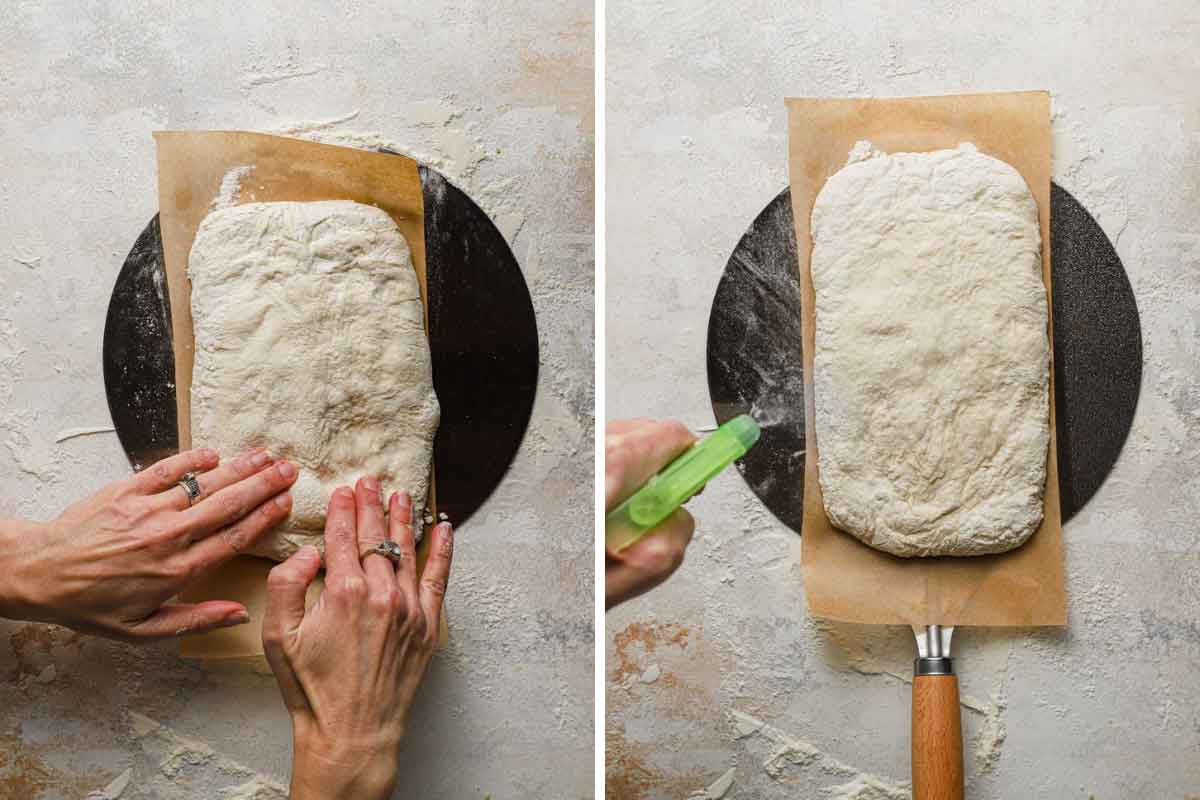
Recipe Notes and FAQ
A few notes and the answers the some commonly asked questions:
- Equipment – To make the most of this recipe, I recommend using the following pieces of equipment: stand mixer / bowl scraper / bench scraper / baking stone / parchment paper / pizza peel / spray bottle / digital instant-read thermometer / wire cooling rack
- Yeast – If you substitute active yeast instead of instant yeast, you will need to be sure to activate it in warm water first, instead of simply mixing it with the flour and room temperature water.
- Milk – Whole milk is preferred, but 2% or 1% can also be used. You can also substitute 2 tablespoons of nonfat milk powder (increase water in dough to 1 cup).
- Stand Mixer – Due to the high hydration of this dough and how sticky it is, a stand mixer is important for being able to manage the dough properly.
- Handling the Dough – Keep in mind that this dough is very wet and sticky; the key to working it well is to do so quickly and gently. Too much heavy-handling of the dough will result in flat, tough loaves. Use a bowl scraper when possible and if you need to use your hands, make sure they are well-floured.
- Baking Stone – If you do not have a baking stone, you can use a baking sheet that is turned upside on the lowest oven rack and preheated as directed.
- Making Ciabatta Rolls – To make rolls, use a bench scrape to divide each loaf into 6 or 8 even-sized portions. Separate them a bit on the parchment sheet so they aren’t touching.
- Storage – The bread can be kept at room temperature, wrapped in foil, for up to 2 days.
- To Reheat the Bread – Keep it wrapped in foil and place in a 450-degree oven for 6 to 8 minutes.
- Freezing the Bread – Wrap tightly in foil, then place in a ziploc freezer bag and freeze for up to 3 months. Thaw at room temperature, then warm and re-crisp the crust using the reheating method above.

More Popular Homemade Bread Recipes
- The Best White Bread Recipe
- Grandma’s Banana Nut Bread
- Copycat Pizza Hut Breadsticks
- Classic Italian Bread Recipe
- Spicy Cheese Bread
Watch How to Make Homemade Ciabatta Bread:
If you make this ciabatta bread recipe and love it, remember to stop back and give it a 5-star rating - it helps others find the recipe! ❤️️

Ciabatta Bread
Ingredients
For the Sponge:
- 1 cup (130 g) all-purpose flour
- ⅛ teaspoon instant yeast
- ½ cup (120 ml) water, at room temperature
For the Dough:
- 2 cups (260 g) all-purpose flour
- 1½ teaspoons salt
- ½ teaspoon instant yeast
- ¾ cup (180 ml) water, at room temperature
- ¼ cup (60 ml) whole or 2% milk, at room temperature
Instructions
- Make the Sponge: Combine the 1 cup flour, ⅛ teaspoon yeast, and ½ cup water in a medium bowl and stir with a wooden spoon until a uniform mass forms. Cover the bowl tightly with plastic wrap and let stand at room temperature for at least 8 hours or up to 24 hours.
- Make the Dough: Place the sponge and the dough ingredients (flour, salt, yeast, water and milk) in the bowl of a stand mixer fitted with the paddle attachment. Mix on low speed until combined and a shaggy dough forms, about 1 minute, scraping down the bowl and paddle as needed. Increase the speed to medium-low and continue mixing until the dough becomes a uniform mass that collects on the paddle and pulls away from the sides of the bowl, 4 to 6 minutes.
- Change to the dough hook and knead the bread on medium speed until smooth and shiny (the dough will be very sticky), about 10 minutes.
- Transfer the dough to a large bowl, cover tightly with plastic wrap, and let rise at room temperature until doubled in size, about 1 hour.
- Spray a rubber spatula or bowl scraper with non-stick cooking spray. Fold the dough over itself by gently lifting and folding the edge of the dough toward the middle. Turn the bowl 90 degrees, and fold again. Turn the bowl and fold the dough 6 more times (for a total of 8 times).
- Cover with plastic wrap and let rise for 30 minutes.
- Repeat the folding as in step #7, replace the plastic wrap, and let rise until doubled in size, about 30 minutes.
- One hour before baking, adjust an oven rack to the lower-middle position, place a baking stone on the rack and preheat the oven to 450 degrees F.
- Cut two 12×6-inch pieces of parchment paper and dust liberally with flour. Transfer the dough to a floured work surface, being careful not to deflate it completely. Liberally flour the top of the dough and divide it in half with a bench scraper. Turn 1 piece of dough cut-side-up and dust with flour. With well-floured hands, press the dough into a rough 12×6-inch rectangle. Fold the shorter sides of the dough toward center, overlapping them like you would fold a letter in thirds, to form a 7×4-inch rectangle. Repeat with the second piece of dough.
- Gently transfer each loaf, seam-side-down, to the parchment sheets, dust with flour, and cover with plastic wrap. Let the loaves sit at room temperature for 30 minutes (the surface of the loaves will develop small bubbles).
- Slide the parchment pieces with the loaves onto a pizza peel. Using floured fingertips, evenly poke the entire surface of each loaf to form a 10×6-inch rectangle; spray the loaves lightly with water. Slides the loaves and parchment onto the baking stone. Bake, spraying the loaves with water twice more during the first 5 minutes of baking time, until the crust is deep golden brown and the loaves register 210 degrees F, 22 to 27 minutes.
- Transfer the loaves to a wire rack, discard the parchment, and let cool to room temperature for at least 1 hour before slicing and serving. The bread can be wrapped in a double layer of plastic wrap and stored at room temperature for up to 3 days. Wrapped with an additional layer of foil, the bread can be frozen for up to 1 month. To recrisp the crust, thaw the bread at room temperature (if frozen), and place unwrapped bread in 450-degree oven for 6 to 8 minutes.
Notes
- Equipment - To make the most of this recipe, I recommend using the following pieces of equipment: stand mixer / bowl scraper / bench scraper / baking stone / parchment paper / pizza peel / spray bottle / digital instant-read thermometer / wire cooling rack
- Yeast - If you substitute active yeast instead of instant yeast, you will need to be sure to activate it in warm water first, instead of simply mixing it with the flour and room temperature water.
- Milk - Whole milk is preferred, but 2% or 1% can also be used. You can also substitute 2 tablespoons of nonfat milk powder (increase water in dough to 1 cup).
- Stand Mixer - Due to the high hydration of this dough and how sticky it is, a stand mixer is important for being able to manage the dough properly.
- Handling the Dough - Keep in mind that this dough is very wet and sticky; the key to working it well is to do so quickly and gently. Too much heavy-handling of the dough will result in flat, tough loaves. Use a bowl scraper when possible and if you need to use your hands, make sure they are well-floured.
- Baking Stone - If you do not have a baking stone, you can use a baking sheet that is turned upside on the lowest oven rack and preheated as directed.
- Making Ciabatta Rolls - To make rolls, use a bench scrape to divide each loaf into 6 or 8 even-sized portions. Separate them a bit on the parchment sheet so they aren't touching.
- Storage - The bread can be kept at room temperature, wrapped in foil, for up to 2 days.
- To Reheat the Bread - Keep it wrapped in foil and place in a 450-degree oven for 6 to 8 minutes.
- Freezing the Bread - Wrap tightly in foil, then place in a ziploc freezer bag and freeze for up to 3 months. Thaw at room temperature, then warm and re-crisp the crust using the reheating method above.
- Recipe from Baking Illustrated
Did you make this recipe?
Leave a review below, then snap a picture and tag @thebrowneyedbaker on Instagram so I can see it!
This recipe was originally published in March 2014.
Photography by Dee Frances.


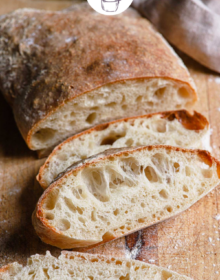



First let me say I have been baking bread for over 25 years, so I have some experience, just not with ciabatta. I followed the recipe, but i had to add about 1/4-1/3 cup more flour, because there was no way this dough would allow itself to be handled – it was more like batter. That is the only thing I did differently. Everything seemed to be going well, and it looked great when it came out of the oven. Unfortunately, I did not get any large air pockets at all. It was very dense. I don’t know if this was caused by the extra flour, but it had to be added in order for me to handle it. Does anyone know what else may have gone wrong? I would like to make it again – but this time I want to get it right. Thanks.
Hi Marl,
I also had to add more flour and it looks like the air pockets are in there. I will let you know tomorrow or later tonight, making it for Thanksgiving. We’ll see how it goes. I like the breads recipe and that is why I chose this one also. Keep you posted.
Your recipe was the first ciabatta bread I tried – very recently. Ever since I first had some, I wanted to try it but I thought it might be too difficult. I have to say your recipe is awesome! I made the sponge the day before. The dough was beautiful and easy to handle. My loaves weren’t equal in size – I’m working on that – but they were delicious! I loved all the holes and the wonderful crust. I also used my steel baking sheet for the first time and it was great, too. The hardest thing was getting the parchment paper with the loaves on them onto the baking sheet but it worked out OK. I am thrilled! My husband said it would be cheaper and less labor intensive to go buy a loaf but there is much more satisfaction in baking it oneself! Thank you so much.
Similar to Linda, for some reason mine didn’t turn out right… I didn’t have a couple things on your list, namely a baking stone and plastic wrap, and I hand-kneaded it. But my crust came out pale and the same color as the interior, not golden brown. Can you explain what causes the bread to turn that color so can understand the process better? Is it just the water?
Hi Maria, The outer crust should brown by a combination of baking and spraying with water.
AMAZING! I didn’t follow the instructions exactly, did more of a normal dough fold (where you take it in your hands, and pull it under itself a few times) and it came out PERFECT. Also – instead of spraying with water, I just put a glass dish filled with water in the over during preheating and baking – still came out AMAZING!
Why oh why can I not bake bread with wonderful big holes? I followed recioe precisely, have made bread for years. But when it comes to a bread that is supposed to be light, airy etc, I end up with dense interior. This was much better than any other, just not the huge ciabatta holes I was hoping for.
Possible help please, I live in Sunny South Africa.(Kitchen room temp 26-28 degree Celsuis). My family and I love ciabattas but mine does not have the same texture, small holes and more bread like on the inside.
Possible remedies?
Thanks for a great web site.
What about baking these in a dutch oven?
Hi Kerri, I don’t think that would work, you want them on an open sheet pan, and I think they would be too large to put into a Dutch oven.
I made the Ciabatta a few days ago. I must not have flattened it enough because mine was kind of a rounded loaf. Mine didn’t have as many holes as yours has, but the flavor was fantastic!! Thanks for a wonderful recipe.
What effect would skim milk have on the bread or its texture? (Dont have any 2% and its too fracking cold to go get some!) Thanks Michelle :)
Hi Jackie, The lack of fat in skim milk could affect the texture of the bread, however to what extent I couldn’t be sure.
Thanks for your response. The bread turned out ok. THe crust had a nice chewiness, but the crumb was smaller than a traditional ciabatta, and not as chewy. That could be not giving it enough “sitting time” as it needed, but maybe that was the result of no milk fat. Anyways… it still went down well with our lasagna and wine! Thanks for the recipe. I’m definitely going to take a 2nd swing at this one… with some milk fat next time.
I had to add a little bit more flour but other than that I folowed the directions exactly as written and it came out delicious and perfect looking
My amazing husband surprised me with a KitchenAid mixer today…I LOVE making bread and usually do it all by hand. Now that I don’t have to the first thing I did was look for a ciabatta recipie and yours looks Amazing! My sponge is done and I can’t wait for tomorrow morning to start baking!
And what if I don’t have a stand mixer?
Dear Michelle
Thank you very much for this recipe! I have never baked bread before and have always wanted to learn how to bake ciabatta, which my family love. Your clear, simple and effective recipe made it possible for me. We have just enjoyed one of my first two loaves of ciabatta baked using your recipe and we absolutely loved it!
i made these today….YUMMY! Thanks for a fantastic recipe! Word of caution! I tried to save a step and placed the loaves on the parchment paper before the final fold, but I didn’t dust them with flour. They stuck to the paper so I couldn’t do the final fold (in thirds). Next time I’ll follow the recipe STEP-BY-STEP! That’s what I get for improvising! Can’t wait to make these again and try some of the other breads on your blog. One question: I’d like to make small sandwich-sized loaves next time instead of two loaves. How long would I bake them, or will the baking time even be reduced at all? Thanks again!
Hi Christy, So glad you loved the bread! I haven’t tried making smaller loaves, so I couldn’t say about the baking time, unfortunately.
Can this be made in a food processor? If so, how would the mixing/kneading times change?
I saw the recommendation to use a wooden spoon to mix by hand – has anyone tried that?
(I don’t have a stand mixer.)
Hi Julia, I would probably do this by hand before using a food processor, as I think it would be too easy to over mix the dough using a food processor.
Very long process took more than an hour to double in bulk and the process of 30 minute rising is very tedious. Still not in the oven yet and has taken all day. Not for those who want bread in a hurry.
This is the second time I’ve made this recipe. It is so good! I have also used just a baking sheet and they turned out wonderfully!
I’ve always love Ciabatta but was terrified to make it, especially since I’ve heard that it’s a soft, sticky dough to work with. But after reading the recipe on your website, I decided to give it a try. I made the sponge yesterday and complete the loaves today. They turned out wonderfully. I don’t have a baking/pizza stone so I used a standard baking sheet instead and it still turned out great. I am no longer intimidated by Ciabatta…Thank you!
So delicious! I only had to bake it for 15 minutes before it was golden brown and I think it may have been way overcooked if I hadn’t kept an eye on it. But such is baking, right? I also didn’t flatten it for the last time, so I ended up with a nice round loaf. Will definitely be making this again.
I followed this recipe to the letter and it turned out wonderful. Nice crumb, great taste and crust.
I have been baking bread for many years with many successes and fails. The hardest part of making bread is timing the risings. Your instructions are so good that they make this easy. As you can tell by the comments, even first timers can be successful.
I think I will try bread flour next time with a little more gluten.
Thanks.
I’ve made this recipe three times and each time was a great succes. Previously, all attempts at bread making had been a fail. I just pulled the last two loaves out of the oven and can hardly wait for dinner tomorrow. I’m up late baking because I forgot about the sponge until 10:00 pm, and I won’t get the chance tomorrow. Love your blog!
Can I freeze this bread and for how long?
Hi Shari, Yes, that’s included in the storage instructions in step #9.
i just made this bread. (yup, it’s 1am). its cooling on my cutting board, and smells delicious…. can’t wait to dig in tomorrow morning! thanks for posting!!
i just made this again… it was TOO good the 1st time! it’s definitely a keeper recipe!
I’ve never made bread before these two times…. can i sub in whole wheat flour to make it a little healthier? if so, would it be cup for cup? curious…
thanks!
Hi Natalie, Yay, so thrilled that you’re enjoying this bread! I have not tried any whole wheat flour substitutions in this recipe, so unfortunately I can’t say for sure how it would affect the recipe.
I have a sourdough starter that I used to make a biga for this. Wow! Used this, Carol Fields, and Nancy Silverton recipes to bake two great loaves! Thanks for feeding my baking addiction.
This looks delicious! Any suggestions on making the dough by hand if you don’t have a mixer?
I haven’t tried it, but you could use a wooden spoon to mix. It’s a quite sticky dough so kneading may be difficult by hand.
Jumped up and started the sponge as soon as I saw this recipe this morning on Pinterest! Was approx 1/8 C shy of the 1 cup of all purpose flour so I combined white whole wheat flour to make up the difference. Much coarser texture to the flour. Hope it turns out! Whole wheat pastry flour is a staple in my pantry but I’m that also! Just couldn’t wait to try you’re recipe. Thanks for posting!
This has been the most fun I’ve ever had making any type of bread. The 1/8 Cup of whole wheat I used a a substitute didn’t affect the finished product at all. Baked 6 loaves in total so far and gave 2 away with rave reviews! Thanks again!
That is one of the prettiest loaves of Ciabatta I’ve seen! I make bread often but haven’t tried Ciabatta yet. It is now next on my list.
I’ve made a lot of homemade bread before (baguettes, sandwich bread, bagels, pizza dough, soft pretzels…etc.) but I’ve never tried making ciabatta. My two loaves are in the oven now–they smell fantastic. Can’t wait to slice some up with some salted butter. Mmm! :)
Made the sponge today and ran out of time to finish the bread. How long will the sponge keep? Should I refrigerate it?
Hi Kimberly, You can keep the sponge at room temperature for up to 24 hours. After that, I don’t recommend using it.
I love baking bread too but I definitely need to do it more often. I can’t believe how easy this is to make!